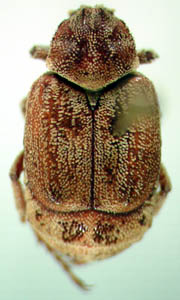| |
|
| Classification |
........Valgus
seticollis (Palisot de Beauvois, 1807)
........Valgus seticollis (Palisot de Beauvois, 1807: 59) (valid name)
........Trichius seticollis Palisot de Beauvois, 1807: 59 (original combination)
........Trichius squamiger Palisot de Beauvois, 1807: 60 (junior synonym) |
| 
|
|
Male |
Female |
Valgus
seticollis. Image
by K. A. Swoboda |
|
Map
showing the distribution of Valgus seticollis. |
|
| |
| Cetoniinae Tribes
|
| |
| |
| Cetoniinae
Taxa Map |
| Key
to species of Valgini
|
| |
| |
| |
| |
| |
| |
| |
| |
| |
| |
| |
| |
| |
| |
| |
| |
| |
| |
| |
| |
| |
Description:
Pronotal disc serrate along lateral edges, transverse medial ridges
well developed; female without pygidial spine; first segment of posterior
tarsus as long as segments two and three combined in males, as long
as two, three and four in females; males yellowish-brown with light-colored
setae, patches of dark setae on pronotum and elytra, ventral surface
with light-colored setae, females reddish-brown with dark setae, patches
of light-colored setae on elytra, ventral surface with light-colored
setae; length 5.0-6.0mm.
|
| |
| |
| |
| |
| |
| |
| |
| |
Distribution: Eastern
United States. States include: ARKANSAS, CONNECTICUT, DISTRICT OF COLUMBIA, GEORGIA, ILLINOIS,
INDIANA, KANSAS, KENTUCKY, MARYLAND, MASSACHUSETTS, MISSISSIPPI, MISSOURI, NEBRASKA, NEW JERSEY, NEW YORK,
NORTH CAROLINA, OHIO, PENNSYLVANIA, RHODE ISLAND, SOUTH CAROLINA, TENNESSEE,
TEXAS, VIRGINIA, and WEST VIRGINIA.
|
| |
| |
| |
| |
| |
| |
Biological
Data: The life history of Valgus seticollis is
probably similar to Valgus canaliculatus. Adults and larvae
are found in wood infested with termites such as Reticulitermes
flavipes (Kollar). Specimens have been collected from oak (Quercus
sp.), Pitch Pine (Pinus rigida), American Chestnut (Castanea
dentata) and Tulip trees (Liriodendron tulipifera), and
from a strawberry plant. Colonies usually contain a majority of females,
although colonies have been observed with males and females in almost
equal numbers.
|
| |
| |
| |
| |
| |
| |
| |
| |
Temporal
Distribution: Adults are collected from March to July and in October and November.
|
| |
| |
Larvae:Third-stage
larva described by Ritcher (1945, 1966).
|
| |
References:
CASEY, T.L. 1915. Valgus Scriba. Mem. Col.
VI:391-394.
JAMESON, M.L. and K.A. SWOBODA. 2005. Synopsis of scarab beetle tribe Valgini (Coleoptera: Scarabaeidae: Cetoniinae) in the New World. Ann. Entomol. Soc. Am. 98(5): 658-672.
RATCLIFFE, B.C. 1991. The scarab beetles of Nebraska.
Bulletin Univ. Nebr. St. Mus. 12:1-333.
RITCHER, P.O. 1945. North American Cetoniinae with
descriptions of their larvae and keys to genera and species (Coleoptera:
Scarabaeidae). Ky. Agr. Expt. Sta. Bull. 476, 39pp.
RITCHER, P.O. 1958. Biology of Scarabaeidae. Annual
Rev. of Entomology 3:311-344.
RITCHER, P.O. 1966. White Grubs and Their Allies. Oregon
St. Univ. Press, Corvallis. 219 p.
|
| |
| |
| |
| |
| |
| |
| |
| |
| |
| |
| |
| |
| |
| |
| |
| |
| |
| |
| |
|
| |

